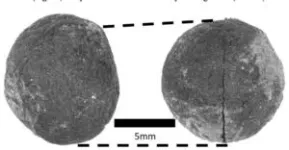(Press-News.org) A trove of ancient plant remains excavated in Kenya helps explain the history of plant farming in equatorial eastern Africa, a region long thought to be important for early farming but where scant evidence from actual physical crops has been previously uncovered.
In a new study published July 10 in the Proceedings of the Royal Society B, archaeologists from Washington University in St. Louis, the University of Pittsburgh and their colleagues report the largest and most extensively dated archaeobotanical record from interior east Africa.
Up until now, scientists have had virtually no success in gathering ancient plant remains from east Africa and, as a result, have had little idea where and how early plant farming got its start in the large and diverse area comprising Kenya, Tanzania and Uganda.
“There are many narratives about how agriculture began in east Africa, but there’s not a lot of direct evidence of the plants themselves,” said WashU’s Natalie Mueller, an assistant professor of archaeology in Arts & Sciences and co-first author of the new study. The work was conducted at the Kakapel Rockshelter in the Lake Victoria region of Kenya.
“We found a huge assemblage of plants, including a lot of crop remains,” Mueller said. “The past shows a rich history of diverse and flexible farming systems in the region, in opposition to modern stereotypes about Africa.”
The new research reveals a pattern of gradual introductions of different crops that originated from different parts of Africa.
In particular, the remnants of cowpea discovered at Kakapel rock shelter and directly dated to 2,300 years ago constitute the earliest documented arrival of a domesticated crop — and presumably of farming lifeways — to eastern Africa. Cowpea is assumed to have originated in west Africa and to have arrived in the Lake Victoria basin concurrent with the spread of Bantu-speaking peoples migrating from central Africa, the study authors said.
“Our findings at Kakapel reveal the earliest evidence of domesticated crops in east Africa, reflecting the dynamic interactions between local herders and incoming Bantu-speaking farmers,” said Emmanuel Ndiema from the National Museums of Kenya, a project partner. “This study exemplifies National Museums of Kenya’s commitment to uncovering the deep historical roots of Kenya’s agricultural heritage and fostering an appreciation of how past human adaptations can inform future food security and environmental sustainability.”
Constantly changing landscape
Situated north of Lake Victoria, in the foothills of Mount Elgon near the Kenya-Uganda border, Kakapel is a recognized rock art site that contains archaeological artifacts that reflect more than 9,000 years of human occupation in the region. The site has been recognized as a Kenyan national monument since 2004.
“Kakapel Rockshelter is one of the only sites in the region where we can see such a long sequence of occupation by so many diverse communities,” said Steven T. Goldstein, an anthropological archaeologist at the University of Pittsburgh (WashU PhD ’17), the other first author of this study. “Using our innovative approaches to excavation, we have been uniquely able to detect the arrival of domesticated plants and animals into Kenya and study the impacts of these introductions on local environments, human technology and sociocultural systems.”
Mueller first joined Goldstein and National Museums of Kenya to conduct excavations at the Kakapel Rockshelter site in 2018. Their work is ongoing. Mueller is the lead scientist for plant investigations at Kakapel; the Max Planck Institute of Geoanthropology (in Jena, Germany) is another partner on the project.
Mueller used a flotation technique to separate remnants of wild and domesticated plant species from ashes and other debris in a hearth excavated at Kakapel. Although she has used this technique in her research in many other parts of the world, it is sometimes difficult to use this approach in water-scarce locations — so it has not been widely used in east Africa.
The scientists used direct radiocarbon dating on carbonized seeds to document the arrival of cowpea (also known as the black-eyed pea, today an important legume around the world) about 2,300 years ago, at about the same time that people in this area began to use domesticated cattle. Researchers also found evidence that sorghum arrived from the northeast at least 1,000 years ago. They also recovered hundreds of finger millet seeds, dating back to at least 1,000 years ago. This crop is indigenous to eastern Africa and is an important heritage crop for the communities that live near Kakapel today.
One unusual crop that Mueller uncovered was field pea (Pisum), burnt but perfectly intact. Peas were not previously considered to be part of early agriculture in this region. “To our knowledge, this is the only evidence of peas in Iron Age eastern Africa,” Mueller said.
The exceptional pea is pictured in the paper, and it represents its own little mystery. “The standard peas that we eat in North America were domesticated in the near east,” Mueller said. “They were grown in Egypt and probably ended up in east Africa by traveling down the Nile through Sudan, which is also likely how sorghum ended up in east Africa. But there is another kind of pea that was domesticated independently in Ethiopia called the Abyssinian pea, and our sample could be either one!”
Many of the plant remnants that Mueller and her team found at Kakapel could not be positively identified, Mueller said, because even modern scientists working in Kenya, Tanzania and Uganda today don’t have access to a good reference collection of samples of plants from east Africa. (As a separate project, Mueller is currently working on building such a comparative collection of Tanzania’s plants.)
“Our work shows that African farming was constantly changing as people migrated, adopted new crops and abandoned others at a local level,” Mueller said. “Prior to European colonialism, community-scale flexibility and decision-making was critical for food security — and it still is in many places.”
Findings from this study may have implications for many other fields, Mueller said, including historical linguistics, plant science and genetics, African history and domestication studies.
Mueller is continuing to work on identifying the wild plants in the assemblage, especially those from the oldest parts of the site, before the beginning of agriculture. “This is where human evolution occurred,” Mueller said. “This is where hunting and gathering was invented by people at the dawn of time. But there has been no archaeological evidence about which plants hunter-gatherers were eating from this region. If we can get that kind of information from this assemblage, then that is a great contribution.”
END
Archaeologists report earliest evidence for plant farming in east Africa
2024-07-10
ELSE PRESS RELEASES FROM THIS DATE:
UQ research reveals exercise brain boost can last for years
2024-07-10
A longitudinal study by University of Queensland researchers has found high-intensity interval exercise improves brain function in older adults for up to 5 years.
Emeritus Professor Perry Bartlett and Dr Daniel Blackmore from UQ’s Queensland Brain Institute led the study in which volunteers did physical exercise and had brain scans.
Emeritus Professor Perry Bartlett and Dr Daniel Blackmore have shown high intensity exercise boosts cognition in healthy older adults and the improvement was retained for up to 5 years.
Emeritus Professor Bartlett said it is the first ...
Researchers identify brain region involved in oxycodone relapse
2024-07-10
LA JOLLA, CA—Even years after they have recovered, a person who once struggled with alcohol or opioid addiction can relapse—and that relapse is more likely to occur during particularly stressful times. Now, Scripps Research scientists have identified an area of the brain that plays a key role in stress-induced oxycodone relapse. Their findings explain why the drug suvorexant, which they previously found to reduce alcohol and oxycodone relapse when administered orally, works so well.
“Having a better understanding of the region(s) in the brain responsible for this kind of relapse is incredibly important as we develop treatments for alcohol use disorder and opioid ...
Daily sugar intake fell by 5 g in kids + 11 g in adults year after UK sugar tax imposition
2024-07-10
Daily sugar intake fell by around 5 g in children and by around 11 g in adults in the 12 months following the introduction of the UK’s ‘sugar tax’, formally known as the Soft Drinks Industry Levy, finds an analysis of 11 years of survey data, published online in the Journal of Epidemiology & Community Health.
The sugar from soft drinks alone made up over half this total, the estimates suggest. But overall daily energy intake from free sugars levels are still higher than the updated recommendation from the World Health Organisation (WHO) of 5%---equivalent to 30 g/day for adults, 24 g for 7–10 year olds, and 19 g for 4–6 year olds—point ...
Osteoarthritis may double risk of speedy progression to severe multimorbidity
2024-07-10
Osteoarthritis—a condition in which the protective cartilage on the ends of bones breaks down—may more than double the risk of speedy progression to accumulating severe long term conditions (multimorbidity), finds a 20 year study published in the open access journal RMD Open.
And there seem to be 4 different speeds of progression to multimorbidity, the findings indicate.
Persistently low levels of physical activity, a high calorie diet, plus chronic low grade inflammation may help to explain the link between osteoarthritis and the risk of accumulating other long term conditions, suggest the researchers.
Although the exact causes aren’t known, injury, age, family ...
Researchers listen to the hearts of bats in flight
2024-07-10
Researchers from Konstanz have measured the heart rate of bats over several days in the wild, including complete flights—the first time this has been done for a bat species. To record the heart rate of male common noctule bats during flight, the scientists attached heart rate transmitters weighing less than one gram to the animals, which they then accompanied in an airplane while the bats flew, sometimes for more than an hour, in search of food. Their results, published in Proceedings of the Royal Society B, show how much energy bats consume over the course of a day and what energy-saving strategies they ...
Familial endocrine diseases linked to increased risk of pregnancy loss, new research shows
2024-07-10
Women who have close family members with endocrine diseases, including type 2 diabetes, thyroid diseases and polycystic ovary syndrome (PCOS), are at higher risk of pregnancy loss, a new study has found [1].
The research, presented today at the ESHRE 40th Annual Meeting in Amsterdam, examined the association between various endocrine diseases and the incidence of pregnancy loss. The study investigated 366,539 women in Denmark between 1973 and 2022.
The study found that women with parents diagnosed with endocrine diseases faced a 6% higher risk of pregnancy loss ...
Health AI expert Nathan Price joins Buck faculty
2024-07-09
The Buck Institute for Research on Aging announces the appointment of Nathan Price, PhD, to Professor and Co-Director of the Center for Human Healthspan. Price specializes in systems biology, artificial intelligence, and bioengineering. He has published more than 200 scientific papers and is co-author, with Buck Chief Innovation Officer and Distinguished Professor Lee Hood, of “The Age of Scientific Wellness.” Price has been named one of 10 Emerging Leaders in Health and Medicine by the National Academy of Medicine and is a member of the Board on Life Sciences of the National Academies of Sciences, Engineering, and Medicine.
Dr. Price is Chief Scientific Officer ...
Greater focus needed on how existing international law can prevent the increasing militarisation of outer space
2024-07-09
There is a pressing need for countries and international organisations to understand better how existing international law can help them address serious concerns about the militarisation of outer space, a new study says.
Space ...
Found with Webb: a potentially habitable icy world
2024-07-09
A international team of astronomers led by Université de Montréal has made an exciting discovery about the temperate exoplanet LHS 1140 b: it could be a promising "super-Earth" covered in ice or water.
When the exoplanet LHS 1140 b was first discovered, astronomers speculated that it might be a mini-Neptune: an essentially gaseous planet, but very small in size compared to Neptune. But after analyzing data from the James Webb Space Telescope (JWST) collected in December 2023 - combined with previous data from other space telescopes such as Spitzer, Hubble and ...
New one-step method to make multiple edits to a cell’s genome
2024-07-09
SAN FRANCISCO, CA—Genome editing has become a widely adopted technology to modify DNA in cells, allowing scientists to study diseases in the lab and develop therapies that repair disease-causing mutations. However, with current approaches, it’s only possible to edit cells in one location at a time.
Now, a team of scientists at Gladstone Institutes has developed a new method that enables them to make precise edits in multiple locations within a cell—all at once. Using molecules called retrons, they created a tool that can efficiently modify DNA in bacteria, yeast, and human cells.
“We wanted to push the boundaries of genomic technologies ...






